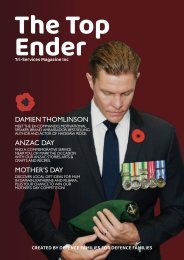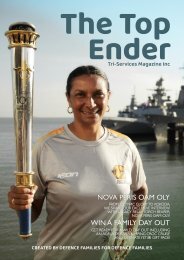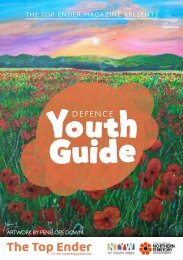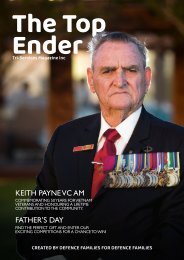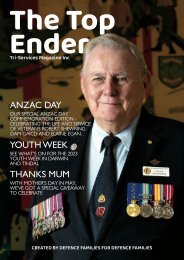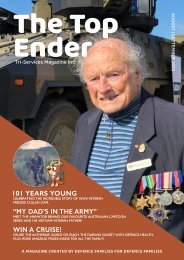The Top Ender Magazine October November 2020 Edition
Oct Nov 2020 Magazine
Oct Nov 2020 Magazine
Create successful ePaper yourself
Turn your PDF publications into a flip-book with our unique Google optimized e-Paper software.
around: there are resident saltwater crocodiles, stingers and
jellyfish, as well as, maybe, the odd 450kg unexploded bomb.
So keep to the safe areas and stay out of the water!
Apart from the turtles, Bare Sand Island and the adjacent
islands of the Grose Islands group are traditionally owned by the
Larrakia people who call it Ngbulbitjik. It is of cultural significance
and the centre of the island, with its single tree is a sacred site,
so visitors are limited and access is restricted.
as well as, maybe, the odd 450kg
unexploded bomb
In their modern history, the island and the adjacent Quail
Island were employed, from the early 1940s until the late 1980s
as a practice bombing range. The many years of practice bombing
has left a large number of large, up to 450kg, unexploded
bombs in the soft sand at various depths.
Since 2013, however, the Department of Defence has
commenced locating and destroying the unexploded bombs,
which are now over fifty years old and somewhat unstable!
Consequently the ongoing work is difficult. The islands are
frequently declared an exclusion zone whilst the remedial detection
and counter-blasting work is in progress, but care is taken
to avoid any disturbance of the turtle nesting sites.
During World War II and until it ceased being used, the area
was known as “Quail Island Air Weapons Range” and that’s
where the tragic incident occurred in May 1944. Number 18
Squadron of the Netherlands East Indies Air Force was based
at Batchelor and was undertaking practice bombing over Quail
and Bare Sand Island. The island appears, from the air, somewhat
ship-shaped and four Mitchell B25 light bombers were
engaged in bombing at what they termed ‘mast height’, in other
words, very low altitude. They made their practice bombing runs
in pairs, and aircraft N5-188 released a bomb, but the water
thrown up by the explosion blew the wings off its partner aircraft
N5-176. N5-176 immediately crashed into the water off the
south-western corner of Bare Sand Island. There were no survivors;
five Netherlands personnel and one RAAF crew member
died in the accident. Then in 2013, during work to locate and
destroy unexploded bombs at Bare Sand, the remains of the
crashed aircraft N5-176 were located and recovered but no
human remains found. Local Historian and tour guide Betty
Franklin recalls seeing part of the wing of N5-176 washed
ashore in 2010. Later, she brought relatives of the deceased
crew to view the island to commemorate their lost ones.
How do you get to see this wonderful place? A local company
named Sea Darwin operates two high-speed craft from
Darwin Port to Bare Sand Island. It is not cheap, and the trip
takes over six hours but has the benefit of highly experienced
guides who have an in-depth knowledge of turtle research and
the area. The trip is a once in a lifetime experience and only
happens with the permission of the Custodians of the Island
and the Department of Defence and the cooperation of the
Moon and the turtles! Apart from the coastal scenery en route,
passing Charles Point historic lighthouse, one is treated to a
gourmet supper and an efficient bar! Passengers must be over
eight years old and all passengers in relatively good health.
It’s a night out you will never forget, you might even go again!
Thank you to Betty Franklin for her assistance in researching
this article.
“Quail Island Air Weapons Range”
and that’s where the tragic
incident occurred in May 1944
Lt Col Mike Bowman (Ret’d)
Photos: Alison Worsnop
October/November 2020 19




